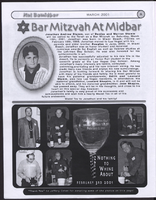Search the Special Collections and Archives Portal
Search Results

Photograph of eight Minsky's cast members on a staircase, Playboy Hotel, Chicago (Ill.), circa 1977
Date
Archival Collection
Description
Image
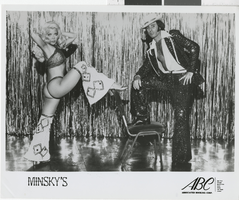
Photograph of two Minsky's Burlesque cast members, Playboy Hotel, Chicago (Ill.), circa 1977
Date
Archival Collection
Description
Image
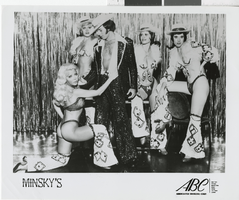
Photograph of the Minsky's Burlesque cast, Playboy Hotel, Chicago (Ill.), circa 1977
Date
Archival Collection
Description
Image
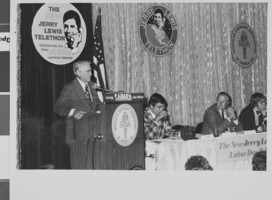
Photograph of Mayor Oran K, Gragson speaking at the pre-telethon production meeting, Las Vegas, Nevada, 1974
Date
Archival Collection
Description
Image
Neon in Nevada Photograph Collection
Identifier
Abstract
The Neon in Nevada Photograph Collection contains black-and-white and color photographic slides of neon signs from cities and towns in Nevada dating from 1913 to 1989. The collection includes slides from Las Vegas, Reno, Boulder City, Laughlin, Henderson, Lovelock, Winnemucca, Elko, Wells, McGill, Ely, Eureka, Austin, Hawthorne, and Carson City. The collection also includes slides from the Young Electric Sign Company (YESCO) that depict the "sign graveyard" in Las Vegas, Nevada of broken and retired neon signs.
Archival Collection
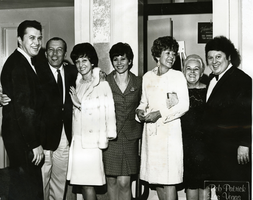
Photograph of Steve Rossi, Ed Sullivan, Toni Clark, Elaine Rossi, Sylvia Sullivan, Frenchy Allen, and Marty Allen, Riviera Hotel, Las Vegas, Nevada, circa mid-late 1960s
Date
Archival Collection
Description
L-R: Steve Rossi, Ed Sullivan, Toni Clark, Elaine Rossi, Sylvia Sullivan, Frenchy Allen, Marty Allen and an unidentified woman near the Versailles Room in the Riviera Hotel, Las Vegas, Nevada. A sign in the lower right corner reads "Bob Patrick, Las Vegas."
Image

Maria Benítez oral history interview: transcript
Date
Archival Collection
Description
Oral history interview with Maria Benítez conducted by Monserrath Hernández and Maribel Estrada Calderón on June 21, 2019 for the Latinx Voices of Southern Nevada Oral History Project. Maria Benítez is the image of a hardworking and determined Salvadoran woman. After facing adversity amidst the Salvadorian Civil War she talks about her journey as a nurse in El Salvador and migrating to the United States. Here in Las Vegas, she has worked as a cook on the Strip, been an active member of her church, and supported the education of her children selling pupusas. Subjects discussed include: El Salvador, Salvadorian Civil War, Migration, US Citizenship Documentation, and Judaism.
Text

Anita Tijerina Revilla oral history interview: transcript
Date
Archival Collection
Description
Oral history interview with Anita Tijerina Revilla conducted by Marcela Rodriguez-Campo on October 09, 2018 for the Latinx Voices of Southern Nevada Oral History Project. In this interview, Revilla discusses her early life in San Antonio, Texas. She talks about her decision to make education a priority, figuring out the college application process on her own, and her initial interest in social justice. Revilla talks about how her critical consciousness was developed, and her pedagogical approach to teaching. Revilla describes her role in the 2006 May Day march, advocating advocating for the queer community, and disrupting oppressive systems to increase educational access for students. Lastly, Revilla discusses ethnic studies and the history of inequality in the United States.
Text

Transcript of interview with Robert "Bob"Agonia by Marcela Rodriguez-Campo, September 6, 2018
Date
Archival Collection
Description
Robert “Bob” Agonia (1938- ) was born in Garden Grove, California on a migrant camp made up of Filipino and Mexican-American workers. Agonia’s father was a farmer on a 70 acre farm owned by the Beggs family. Agonia did not spend much time living on the migrant camp, as his father moved the family to a private residence when Agonia was four. Agonia attended school, during an era of school desegregation in Garden Grove. He recalls that his mother dealt with segregation during her schooling, being forced to attend a school miles down the road from her home despite living across the street from another school. Agonia recalls his community being very diverse with families sharing Filipino and Mexican-American heritage and his neighbors being Japanese Americans. Agonia participated in a multicultural Boy Scout troop. After high school, Agonia joined the Peace Corps and served in El Salvador. While there, Agonia worked in an agricultural research center in Santa Tecla where he helped local farmers select the proper insecticide for their crops. After the Peace Corps, Agonia had his choice of government jobs, ultimately selecting to work for the Internal Revenue Service. Agonia’s work with the IRS is what eventually brought him from California to Las Vegas. He quickly realized that the type of IRS cases he would be handling in Las Vegas were completely different from the work he was accustomed to in California. One of those unique cases required him to close the doors of a downtown casino. Since moving to Las Vegas, Agonia was critical in establishing a Las Vegas LULAC chapter, an American GI Forum, an EEO council, and the UNLV Engineering school.
Text

